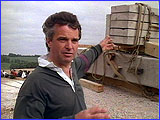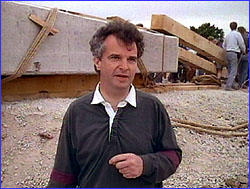
|
 |
 |
Mark Whitby, Engineer NOVA: Can you describe what your everyday work is like when you're not called off to Egypt to help raise an obelisk? WHITBY: I'm a partner in an engineering practice that builds a whole range of structures, from buildings to bridges. Some are quite ordinary, small-scale projects, and quite a number are large-scale projects. But in my time I've been involved in quite special projects, like buildings in Antarctica, or special "millennium bridges," which are part of a riverside landscape scheme that's meant to extend the enjoyment of rivers in York and Lancaster. NOVA: Have you had any previous experience with a project like the obelisk-raising one? WHITBY: I worked on the NOVA Stonehenge program with the stonemason Roger Hopkins. And much to our surprise, we were able to move a 40-ton stone, turn it up on its end and put a another stone on top of it. That's why I'm involved on this occasion. The raising of the obelisk, particularly after all the effort that's gone into it, is quite different from putting up a trilithon at Stonehenge. NOVA: Yes, in fact you used a different method with the Stonehenge project than you'll be using this time, and it seemed to work beautifully. Why are you trying a new method for raising the obelisk? WHITBY: At Stonehenge we literally threw the stone into a hole. The obelisk fits on top of a large plinth and has had considerable work put into it before it's been erected. You're talking about thousands if not millions of man-hours of work in getting this stone out of the ground and then carving it before it's erected. It's quite clear that it has to be treated very gently. I wouldn't like to mention what happened to the person in charge of erecting one of these obelisks in the past, had it broken when he was putting it up. There is a story of a pharaoh tying one of his children to the tip, in order to make sure that the obelisk was treated with due deference. They're very, very special things and would have been handled very gently.
WHITBY: As an engineer, I think one has a way of thinking that has been developed by working with objects, which is terribly relevant. I appreciate the need to think things through in detail, although I can guarantee you that we won't be able to anticipate all the problems that will happen in advance. Our job is to literally plan the process: Think about what might go wrong, try and remedy that, and actually calculate (I believe they calculated in those days, although they may not have used quite the same systems as we do today) calculate what will happen as we do it, so you can anticipate how strong the rope needs to be and what the effect of the flexibility of the rope is, and what numbers of people you need to apply the necessary forces to make it work. NOVA: How will this attempt be different from the obelisk-raising attempt in 1994? WHITBY: It's fundamentally different. It'll be a much more gradual process. We learned things when we put up Stonehenge, which made me realize there are other ways of doing things. Clearly there are always a number of ways of doing things. On this occasion, we're aiming to use a modest number of people—not necessarily any less than we used at Stonehenge—but we aim to operate with a much higher degree of control. The ambition is to literally rotate the obelisk onto its base. And then, at the final moment, just pull it to upright. Obviously, if you pull too hard when you're pulling it upright, you can pull it over. So you need to be very careful. It's a big object. It weighs a lot. And if you pulled it over, you could be guaranteed that you'd have been the next person to volunteer for— NOVA: —for quarrying ? WHITBY: Yes. Or even worse. This time we're aiming to literally pull it. And as it turns, the center of gravity moves nearer and nearer to the turning point. So you've got to be careful. If you had to turn it on the center of gravity, very quickly the center of gravity—which lies in the middle of the stone, whereas the turning point lies on the bottom face of the stone—moves in front, so the obelisk runs out of control. What we have to do is remain in control all the time, so that it doesn't suddenly take over, in which case you could be guaranteed problems. NOVA: What do you think is the most difficult aspect of this whole project? WHITBY: Co-ordinating with Owain Roberts and Roger Hopkins, no doubt! I already know Roger, having worked with him before. I know it'll be fun. On Stonehenge, one had no idea of whether it would work. Now I'm a little more confident about things. Owain, on the other hand, I don't really know yet. He has a hard task ahead of him - we've got to rely very much on his naval skills and his ability to tie knots. And it's terribly important that we get that right. Any slippage in the ropes is going to cause the thing to move out of position.  NOVA: What odds do you give the project of
succeeding?
NOVA: What odds do you give the project of
succeeding?WHITBY: I would conservatively say better than 50/50. In my mind, it shouldn't be a great problem. We're not talking about the biggest obelisk in the world. We're talking about 40 tons as opposed to 400 tons. And the Egyptians had confidence; they thought about cutting out 1,000-ton obelisks. If we can't do it with 40 tons, we've really got to question what's going on. What's nice about this project is it does humble one and makes one appreciate much more the skill of the time. The strange thing is that history tends to imagine that people are constantly improving and learning new things. As they constantly improve and learn new things, they forget some things. What this will expose is just how much we've forgotten. NOVA: Do you think that the methods you're using this time might be the method that they used? WHITBY: I think we'll be fairly close. We can never be sure exactly how they did it. We're fairly certain they may have used a number of methods. The nice thing about working with Mark Lehner is that Mark gives you an insight into their ability at the time. And there's quite a lot of evidence of their ability to put up large earth ramps; there's evidence in terms of turning grooves in the stones, which presumably lie in the direction the obelisks would have come down from. When it comes to the point of literally turning the obelisk through the last few degrees, we'll be as near as possible to whatever they might have done themselves, because the stone will be in that position. There will always be a question about whether they used a great sand mound and had means of excavating it. But I would imagine that there would have been a number of ways of putting up obelisks in their day. We'll be very close to one of them. NOVA: What do you expect to learn from this whole project? WHITBY: Probably just how difficult it is to get everything organized to do a project like this in the current culture. When we were in Stonehenge we had British contractors around; we were able to put a lot of things together that were based on modern day abilities. We had a crane and other things. In Egypt it's going to be a bit tougher than that. We won't be able to just run out the door and buy something. NOVA: It'll keep you honest. WHITBY: It's going to be hard work, you know. Explore Ancient Egypt | Raising the Obelisk | Meet the Team Dispatches | Pyramids | E-Mail | Resources Classroom Resources | Site Map | Mysteries of the Nile Home Editor's Picks | Previous Sites | Join Us/E-mail | TV/Web Schedule About NOVA | Teachers | Site Map | Shop | Jobs | Search | To print PBS Online | NOVA Online | WGBH © | Updated November 2000 |
 Mark Whitby
Mark Whitby Mark Whitby supervised the NOVA Stonehenge project
with great success.
Mark Whitby supervised the NOVA Stonehenge project
with great success.